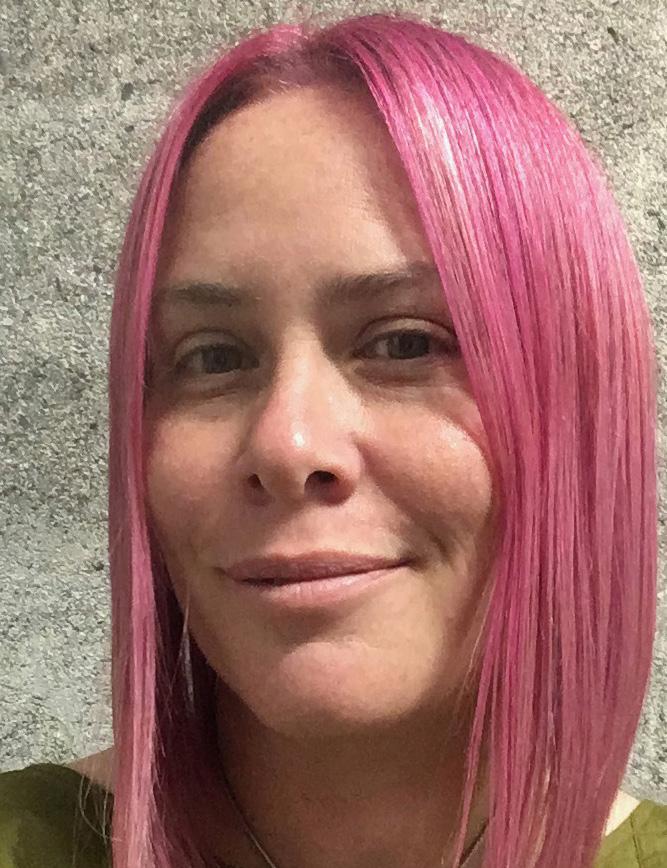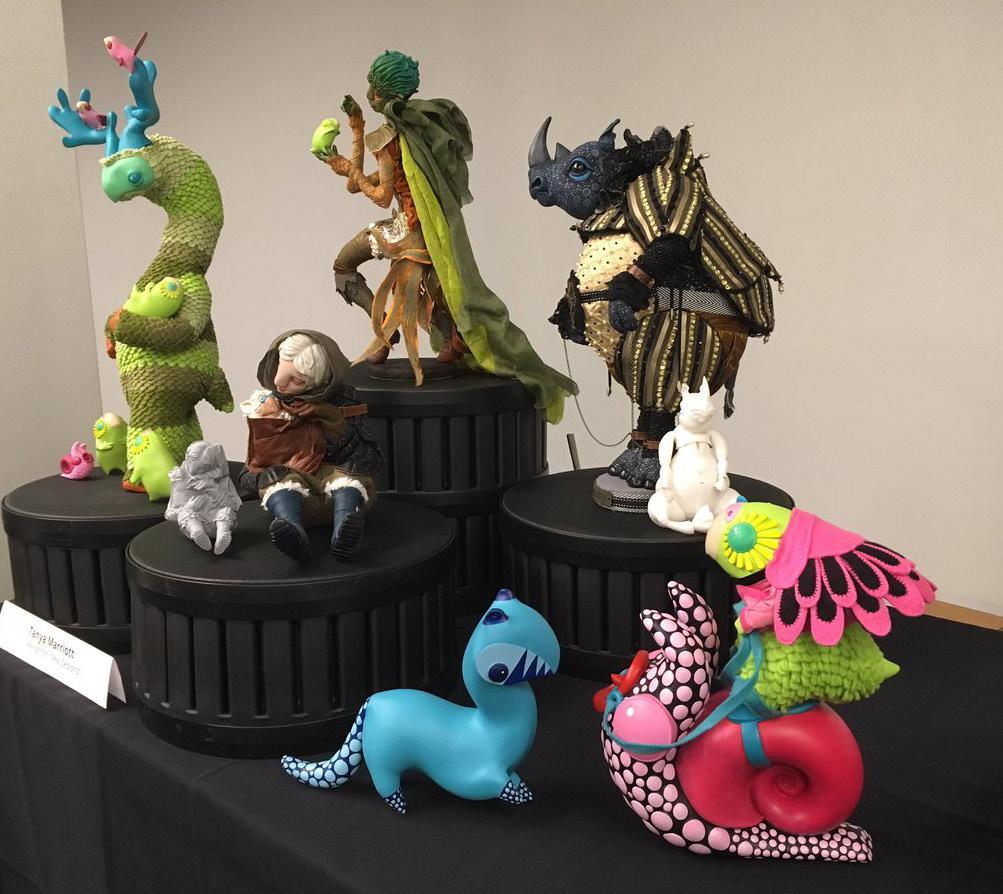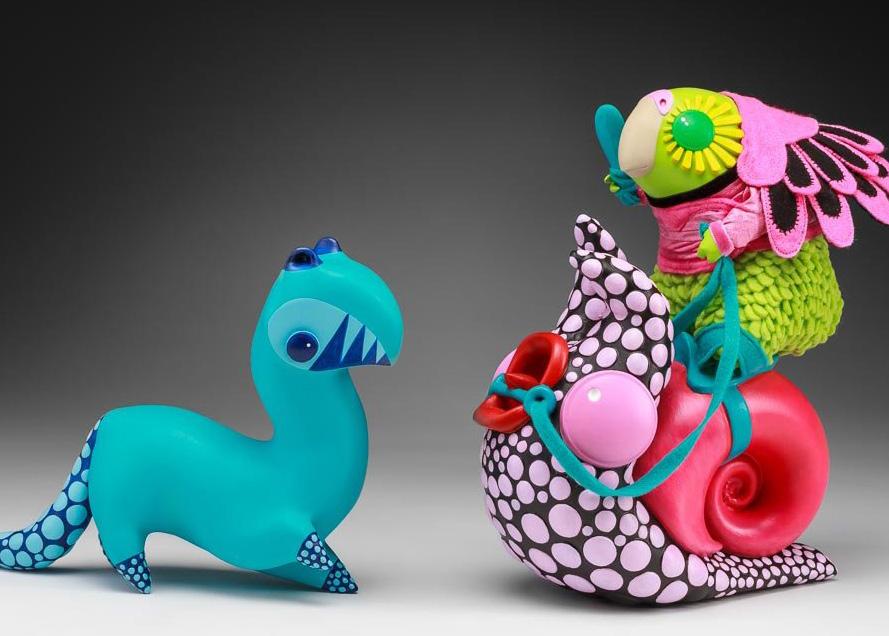
11 minute read
MARRIOT Tanya


Advertisement
When did you first think about art/dollmaking as something you wanted to do? Were you encouraged or discouraged by family, friends, teachers, mentors? Anyone stand out as a supporter?
I started making dolls when I was about 10 years old when I went to a school holiday doll making workshop for a day - we painted porcelain pieces and made a baby doll. I was really intrigued with the process and came home and had a go at making my own doll. I have been making little critters in Fimo, so I had a crack at sculpting a head, hands and feet, with a soft body construction and hand-sewn clothing. I made “Will Scarlet” played by Christian Slater in the Robin Hood film - now I’m showing my age!!! I took it back to the doll shop to show my tutors. One of the doll shop owners told me it was the most horrific thing they had ever seen!!! The other thought it was wonderful. She became my life long mentor and supporter, we have been friends for 30 years now :) My parents encouraged all of my wild creations. My mum is a textile designer and taught me to sew, and dad the engineer helped me with construction problems. They used to joke that my bedroom was like a museum and that they could sell tickets. They were immensely proud, even if they didn’t always get what I was making. My husband Garry is my most stand-out supporter, he keeps me grounded and helps me to refine my craft. We share a studio together and often collaborate on projects.
What kind of kid were you? Where did you grow up? What were your influences?
I was a very outgoing and noisy kid, always busy making something. I grew up in Taranaki and Wellington in New Zealand. All of my childhood homes backed onto farm or forest land, so I spent my childhood outdoors building tree forts with the local kids. My indoor time was spent sculpting, sewing and drawing, and building very badly made cardboard models! I was really into conservation and was a member of the Kiwi Conservation club, I was also a keen reader of fantasy novels. The Lord of the Rings was my ultimate favourite and the Dragonlance series, and my earliest dolls were characters from these books. Later on I was lucky to get work at Weta Workshop on the Lord of the Rings trilogy, and more recently I did some volunteer work with Kakapo recovery - I feel my doll work has enabled me to come full circle to achieve my childhood dreams.

Your style is very unique. Did you work on developing a style or is that what naturally came out of you?
For years I just focused on becoming a better dollmaker and crafter - I honed my sculpting skills, and refined my modelmaking to build more elaborate and technically complicated pieces. I made a lot of dolls that were riders, so I needed to work out how to make animal characters, as well as making pieces that were structurally strong. For years my work was very dark and gothic - it was an aesthetic of the time and many of my fellow artists worked in a similar style. About 15 years ago I started to combine my doll and toy aesthetic together. I had been working in the toy industry and I was keen to try making more toy like designs. I was really inspired by the character personification that toys and dolls for play have. I was very keen to play with colour and more pure shape language. I wanted to develop a style that had shapes that were proportionately iconic (I was inspired by the golden section) and I wanted to bridge the gap between doll and toy. I was very inspired by the pop-surreal movement and my artist heros are Nathan Jurevicius, Tara McPherson, Jeff Soto and Femke Hiemstra. By then I was making almost exclusively anthropomorphic characters, I find animal shapes and textures really fascinating, and they have so much scope for characterisation. In 2011 I joined the National Institute of American Doll Artists as an artist member, it is a requirement for membership that our work shows a signature style, so I worked really hard to define a style that was uniquely my own. I found drawing my ideas out before sculpting really helped to keep my design on track in the development process. Although trained in design, my dolls were always developed organically, as a reaction to what I was feeling when I worked with clay and fabric. The key I found to developing my style was ensuring I planned my designs, and staying true to the design schema throughout the making process.
Your work is whimsical. How did that happen?
My design aesthetic is guided by magical realism. I ground my characters within a believable reality, often referencing the lives and ecosystems of existing species, and then add a fantastical element. I am really interested in the notion of Kaitiakitanga (guardianship) and the relationships between my characters and those who protect, guide and nurture them. I use my characters to discuss difficult conservation narratives such as predation and habitat destruction, so I use the playfulness of my designs to engage the audience to empathize with my characters and their plight, and to take the time to stop and listen to their stories.

Has the computer affected your work? Do you work traditionally and digitally?
Computers have completely revolutionised my work! I still work in both traditional polymer clays and 3D printed resins, both have benefits in my making process and yield different aesthetics. I work in Maya and Zbrush and I work in Maya and Zbrush and then 3D print on a Formlabs

(Continued)

Form 2 printer. We call it the “magic cupboard”. You send files down a usb cable to a cupboard, then several hours later a tangible design appears! I love being able to scale and iterate my work, and the digital pipeline enables me to do this. I can work with the same character and re-pose them in different dimensional illustrations and then print them out. I have made automata, and Zoetropes using 3D printers that would been incredibly difficult to make by hand. I still paint and costume all my dolls and toy by hand, and just use 3D printing in the sculpting process. I also sculpt by hand, but I find the output is slightly wonky and not symetrical - my hands shake a bit, but I see this as all part of the physical authenticity of the piece. I find nothing beats being able to see your work tangibly, and I find when I am working with polymer clay pieces I am definitely more experimental, as I still tend to work out the design as I am going along.
What’s going on in your head when you work on a piece? Your fears, anticipation, confidence, etc. How do you know something is finished? Something is finished when it hits the deadline! I am a bit of a night owl and I tend to keep working on my dolls right up until the moment they head to the gallery. I find doll-making really cathartic, and very really do I love the process. I find my technical limitations frustrating sometimes, and I need to take the time to do each step properly, especially where sometimes I am just too eager to get to the next step. Sometimes a doll just doesn’t speak to me and I need to put it aside and work on something else. I often work on several pieces at once so that I can vary the work. Even if I do put a doll down, I will go back and finish it. Some of my most favourite pieces are remade dolls.
What does the future hold for your puppetry and film-making?
We are seeing quite a resurgence for the handmade and tangible puppets, prosthetics and models being used within film and animation. Tangible designs are real, they are governed by real world physics and can do some really unexpected things when challenged.
I think audiences are looking for something more real. Digital effects and characters are amazing, and it is incredible what you can do in a CGI environment, this is also based on reality - but a more hyper fabricated reality. I feel there is nothing like working with the actual source material in front of the camera, and witnessing the serendipitous moments that only happen by happenstance in the “real world”. I have shot a few puppet films and it is amazing how quickly the characters become real living breathing actors. The magic begins when you start to play with the object.
I’m curious about how you choose what to work on. What does your process entail? Start to finish. Can you give us a short step-by-step? Either a personal project or an assignment.
Most of my characters are designed as character sets, with variations on the same scene so I can explore different personalities within each design. I generally start with a brief as to what I am going to create a doll or a toy. I spend time exploring the world they might inhabit, their environment, social structure, species, character personality, and then I start to draw. My drawings are usually quite rough and sketchy and they serve as a shorthand blueprint for the design that I’m going to make. The next stage is sculpture. Whether I am working in digital or physical clay, I start with a head and then move onto the hands and feet. Depending on whether the body is solid or fabric sculpture I will create a wire armature base which I will wrap with batting and fabric to build up the musculature and the body. Sometimes I will build up the body with epoxy clay to make a solid form and then sculpt back into the surface. I tend not to have a consistent form of making, rather I adapt it to what is required for each figure. Next, I sculpt hair, and then I begin to paint the figures. I use acrylic paint, and build it up with a dry brush technique, and then seal it with a matte coating. The costuming comes last and this is one of my most favourite parts of the process as this is where the character ready gets its personality, and I get to play with how they pose and how they look. Sometimes the character will start standing and I will adjust its position to sitting as I’m developing it in order to get the pose to best suit the story it needs to tell. I collect a lot of vintage fabrics and materials which are used to build the costumes.
What do you do to promote yourself and get work? Do you work worldwide? I am an artist member of the National Institute of American doll artists and I exhibit with them annu ally in the USA and in Europe at a variety of doll shows. I have had my work published in various magazines and books through the years and through these opportunities I have built-up a following, and have been picked up by a variety of galleries through these connections. I promote my work mainly on Instagram currently but I do use Facebook as a way of documenting my process. I am part of several New Zealand based creative communities which collectively help to give exposure to me work. In my professional work I am a senior lecturer in design, teaching into concept design for animation, toy and game. My character designs are part of my research work, so I also attend academic conferences to discuss the power of characters as communicators. I had my first solo show in 2003 in New Zealand I lived in Canada and the UK which really helped to connect me with the international character world. I have also participated in the Pictoplasma character Academy in Berlin, and exhibitions at Stranger Factory and Mothership Gallery which has opened up some amazing opportunities to exhibit with fellow international toy designers.
What’s the future hold for you? Any ultimate goal?
My immediate goal is to complete my PhD!. My project looks at how to effectively design toys with eco-fiction narratives, that encourage children to play in the outdoors. I see this as a wonderful opportunity for me to develop a variety of character designs and toy ranges that have been in my head for a really long time. I am doing my PhD part time while I’m teaching so I have another four years to go. Long term, when I’m old and grey I would like to retire to a remote island and run an artist retreat and work on designing my dolls and toys full time. In the midterm I really love the academic life, mentoring and supporting young designers in developing characters and worlds and telling amazing stories.
If you could meet anyone in the field you’re in who would it be and why?
I feel I’ve been incredibly privileged to have met many of my design heroes so I think the one person I would love to meet with the Lauren Faust who was the designer for the My Little Pony Friendship is Magic reboot. I am a huge My Little Pony fan, and have a large collection of the first generation ponies. I would love to talk with her about her design process and her reasoning behind the world she created for the new ponies. I have also recently been down a rabbit hole collecting artwork and researching toy industry packaging illustrators. In the 1980s almost all toy packages had hand illustrated watercolour images, which set the context for the product. The work is amazing! And I would love to meet and talk to these illustrators.






